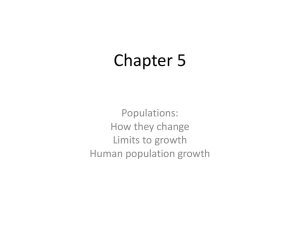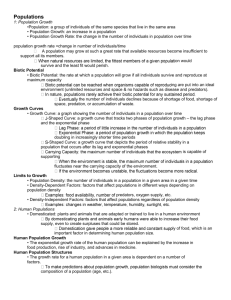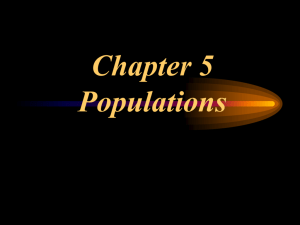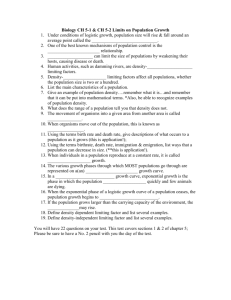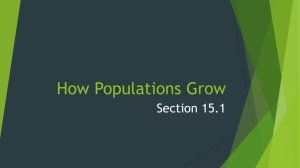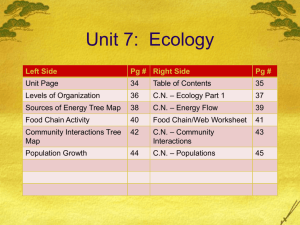Populations
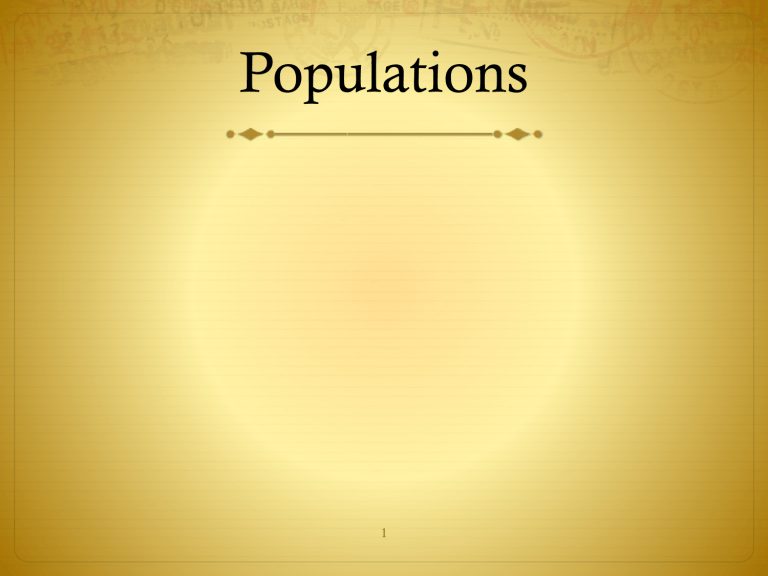
Populations
1
Objectives
Distinguish among the three patterns of dispersion in a population.
Contrast exponential growth and logistic growth.
Differentiate r-strategists from K-strategists.
2
I. What Is a Population?
A.
A population consists of all the individuals of a species that live together in one place at one time.
B.
Every population tends to grow because individuals tend to have multiple offspring over their lifetime. But eventually, limited resources in an environment limit the growth of a population.
C.
The statistical study of all populations is called demography.
3
D. Three Key Features of Populations i.
The number of individuals in a population, or population size, can affect the population’s ability to survive.
ii.
Population density is the number of individuals that live in a given area.
iii.
A third feature of a population is the way the individuals of the population are arranged in space. This feature is called dispersion.
4
Three Patterns of Population Dispersion
5
II. Modeling Population Growth
A.
When demographers try to predict how a population will grow, they make a model of the population.
B.
A population model is a hypothetical population that attempts to exhibit the key characteristics of a real population.
C.
By making a change in the model and observing the outcome, demographers can predict what might occur in a real population.
6
D. Growth Rate i.
A population grows when more individuals are born than die in a given period.
ii.
So a simple population model describes the rate of population growth as the difference between the birthrate and the death rate.
iii.
For human populations, birth and death rates are usually expressed as the number of births and deaths per thousand people per year.
7
E. Growth Rate and Population Size i.
When population size is plotted against time on a graph, the population growth curve resembles a J-shaped curve and is called an exponential growth curve.
ii.
An exponential growth curve is a curve in which the rate of population growth stays the same, as a result the population size increases steadily.
iii.
The population size that an environment can sustain is called the carrying capacity (K).
8
Exponential Growth Curve
9
Limiting Factors and Carrying Capacity
10
F. Resources and Population Size i.
The population model can be adjusted to account for the effect of limited resources, such as food and water. These resources are called density-dependent factors because the rate at which they become depleted depends upon the population density of the population that uses them.
ii.
The logistic model is a population model in which exponential growth is limited by a density-dependent factor.
11
Logistic Growth
12
III. Growth Patterns in Real Populations
A.
Many species of plants and insects reproduce rapidly.
Their growth is usually limited not by densitydependent factors but by environmental conditions, also known as density-independent factors.
B.
Weather and climate are the most important densityindependent factors.
C.
The growth of many plants and insects is often described by an exponential growth model. The population growth of slower growing organisms, such as humans, is better described by the logistic growth model.
13
D. Rapidly Growing Populations i.
Many species, including bacteria, some plants, and many insects like cockroaches and mosquitos, are found in rapidly changing environments.
ii.
Such species, called r-strategists, grow exponentially when environmental conditions allow them to reproduce.
iii.
This strategy results in temporarily large populations. When environmental conditions worsen, the population size drops quickly.
14
E. Slowly Growing Populations i.
Organisms that grow slowly, such as whales, often have small population sizes.
ii.
These species are called K-strategists because their population density is usually near the carrying capacity (K) of their environment.
iii.
K-strategists are characterized by a long life span, few young, a slow maturing process, and reproduction late in life.
15

